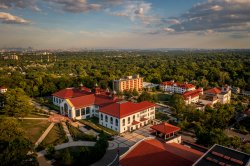Opinion: Why do Indian students prefer America as a study destination?
Posted in: Featured Links, Opinion

This Op-Ed was published March 2, 2024 on Financial Express.
_______________________________________________________________________________________________
The popularity of pursuing education abroad is on the rise. The number of Indian students studying abroad rose steadily after the height of the COVID-19 pandemic, reaching a six-year high in 2022, and the U.S. welcomed more students from India than ever before. Second only to China, India reached an all-time high in international student enrollment in the U.S. last year, as America issued a record number of student visas.
Both countries gain a great deal from this valuable partnership, propelled by significant changes in immigration policies. Students are exposed to academic excellence, diverse programs and research opportunities, professional development, and cross-cultural immersion. American universities benefit from the talent and diversity Indian students bring to campus, enriching their intercultural exchange of ideas and expertise.
For students and families, choosing where to study abroad can be overwhelming when faced with thousands of choices. While it might be tempting to focus on the more well-known or exclusive schools in the U.S., it’s important to keep in mind that many others pair excellence with accessibility. By looking beyond the most “famous” institutions, you will realize that some schools are not only more affordable, but they offer even more opportunities to transform the lives of students.
Several practical considerations, interests, and career goals must be carefully considered when choosing a degree program. Beyond academic quality and cost, here are some other areas to explore:
Location
The location of a university can have a huge impact on the student’s overall experience, both in terms of feeling “at home” as well as proximity to external opportunities. Factors to consider include an urban, suburban, or rural environment; climate; access to job, internship, and networking opportunities in the region; and the cultural makeup of the area.
If retaining close ties to India while studying abroad is important, refer to organizations like Indian American Impact to better understand the Indian presence in different states. For example, Indians make up the majority of the state’s immigrant population in New Jersey, where Montclair State University is located. In February 2024, Governor Phil Murphy announced the launch of the New Jersey-India Commission to further promote cultural and educational exchanges between the two.
Inclusive Environment
Beyond the wider region, consider how important diversity is within the campus community. One of the best parts about studying abroad is the opportunity to engage with others from all over the world. To get that experience, which is so important for fostering future leaders who understand and appreciate cultures outside of their own, it’s crucial to be in a truly inclusive environment.
Schools like Montclair offer resources for student belonging and assimilation, with dedicated programs to make sure all students are positioned to thrive regardless of their background. But this is not the same at all schools, as recent legislative changes in parts of the country have changed how these initiatives are structured. It’s important to do due diligence to explore what is available to meet your needs.
Employable Degrees
Schools must move quickly to update and introduce programs to meet the changing needs of the workforce. For example, consider programs that are specifically designed to meet growing demands for computer & data scientists, address the public health crisis, and tackle the global teacher shortage.
Many university programs offer hands-on learning experiences outside of the classroom, offering the opportunity to engage in internships, apprenticeships, and networking opportunities with employers. These experiences offer transferable skills for job prospects all over the world.
Focus on Output
Many schools will boast of their exclusivity and low acceptance rates, but the marginal effect of attending that university should matter much more. The main question to ask is not “How many students got rejected?” but “How will earning a degree from this institution alter the trajectory of my life?”
Media outlets like U.S. News, World Report and Wall Street Journal have tried to answer this question by focusing on factors like graduation rate, value added to a graduate’s salary, and the amount of time it takes to pay off student debt. Their rankings show how institutions change the lives of students and their families by evaluating who offers affordability without compromising quality. They, therefore, describe the best institutions as engines of social mobility, something that resonates with Indian students considering earning a degree abroad.
The increasing trend of Indian students pursuing higher education in the US is promising and exciting. Linking the deep talent pool in India with the academic resources and research opportunities at American universities is a recipe for advancement that benefits the entire world.
